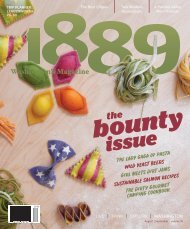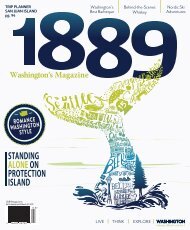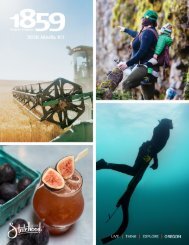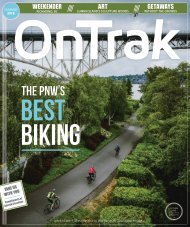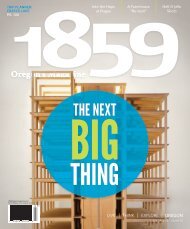You also want an ePaper? Increase the reach of your titles
YUMPU automatically turns print PDFs into web optimized ePapers that Google loves.
Until Next Time<br />
Hoisting the Sails in the San Juans<br />
written by Lori Sweeney<br />
I’M AT THAT SEASON in life when, if I bend over, I<br />
think about the consequences. Will I get back up? What<br />
will be damaged in the process? What shows?<br />
On the Schooner Zodiac, thirty women raised four<br />
sails daily. The main sail weighs 1,800 pounds, and<br />
hoisting it took ten minutes, longer if you were on the<br />
peak (that log on the main that had to be raised 110<br />
feet). Taking it down meant taking a knee to let out 600<br />
feet of the halyard, then unceremoniously climbing up<br />
on the boom and stuffing it all back in. Women my age<br />
are familiar with stuffing it all back in, but this involved<br />
bending over.<br />
The whole experience of being on the “Z” involved<br />
learning. Tim Mehrer and his high school friends bought<br />
the Schooner (so called because it has more than one<br />
mast and the main sail is on the taller mast) in the mid-<br />
1970s. They restored all 127 deck feet back to her 1924<br />
glory, no small feat given she’s made of wood. They teach<br />
every passenger about tall-ship sailing—every passenger<br />
learns to chart, steer, swab the deck with seawater, learn<br />
“aft” and other jargon and hoist those four sails.<br />
Day one is like childbirth. It’s exhilarating. But then<br />
it’s hard (did I mention hoisting that main sail?), and you<br />
wonder if you’ll ever raise your arms above your head<br />
again. You finish and the sense of accomplishment is no<br />
small thing, but then you realize the bunk is a small thing<br />
and you wonder if your bent-over back will recover in<br />
this odd-shaped mattress. You never slept so well.<br />
... Or ate so well. The only paid person on the ship is<br />
the cook, and she is so worth it, providing fresh produce<br />
and good coffee and enough chocolate to keep thirty<br />
women happy.<br />
You learn to have the highest respect for the ten<br />
women who are the volunteer crew. They know this ship<br />
inside out. They crawl belowdecks to the chain locker<br />
with ear protection and bare feet to lay the anchor<br />
chain evenly. They “sweat” the line 25 feet to hoist three<br />
dinghys and all that rigging. Never stern (pun intended),<br />
these muscled, good-natured women showed us the<br />
ropes on this all-woman sail. They never gave into the<br />
fatigue, and patiently showed us a ballantine coil for the<br />
sixth time.<br />
Plying through the water in the San Juans, anchoring<br />
in a quiet bay, enjoying the fine summer weather and<br />
working hard at something so satisfying, so seemingly<br />
unattainable at this juncture in life, was the best<br />
experience. Becalming, as the sailors say. Repeatable.<br />
Memorable. A grand story.<br />
Travel, at it best moments, helps us rethink how we do<br />
life. It renews our senses, introduces us to a whole new<br />
vocabulary of life. The Schooner Zodiac did all that for<br />
me in three days. It helped me bend over. Ahoy!<br />
Brenda Lawrence<br />
88 <strong>1889</strong> WASHINGTON’S MAGAZINE FEBRUARY | MARCH <strong>2018</strong>









